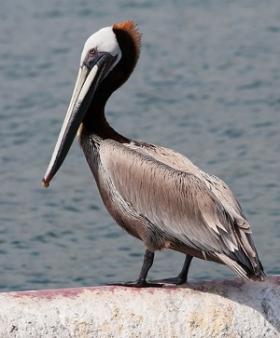 After 40 years on the brink of extinction, the brown pelican has fully recovered and is being removed from the list of threatened and endangered species, the U.S. Fish and Wildlife Service yesterday announced.
After 40 years on the brink of extinction, the brown pelican has fully recovered and is being removed from the list of threatened and endangered species, the U.S. Fish and Wildlife Service yesterday announced.
“At a time when so many species of wildlife are threatened, we have an opportunity to celebrate an amazing success story,” said Interior Secretary Ken Salazar. “Today is such a day. The brown pelican is back!”
Their population decimated by the pesticide DDT, the pelican species was first declared endangered in 1970. Since then, thanks to a ban on chemical and efforts by states, conservation organizations, private citizens and many other partners, the bird is no longer in free fall. There are now more than 650,000 brown pelicans found across Florida and the Gulf and Pacific Coasts, as well as in the Caribbean and Latin America.
“After being hunted for its feathers, facing devastating effects from the pesticide DDT and suffering from widespread coastal habitat loss, the pelican has made a remarkable recovery,” said Tom Strickland, Assistant Secretary for Fish and Wildlife and Parks, at a press conference in New Orleans to announce the delisting. “We once again see healthy flocks of pelicans in the air over our shores.”
The pelican’s recovery is largely due to the federal ban on the general use of the pesticide DDT in 1972. This action was taken after former U.S. Fish and Wildlife Service biologist Rachel Carson published Silent Spring and alerted the nation to the widespread dangers associated with unrestricted pesticide use.
The Fish and Wildlife Service removed the brown pelican population in Alabama, Georgia, Florida, and northward along the Atlantic Coast states from the list of endangered species in 1985. Yesterday’s action removes the remaining population from the list.
In the southwest, the Texas Parks and Wildlife Department, The Nature Conservancy and numerous other conservation organizations helped purchase important nesting sites and developed monitoring programs to ensure pelican rookeries were thriving.
Louisiana, long known as the “pelican state,” and the Florida Game and Fresh Water Fish Commission jointly implemented a restoration project. A total of 1,276 young pelicans were captured in Florida and released at three sites in southeastern Louisiana during the 13 years of the project.
Past efforts to protect the brown pelican actually led to the birth of the National Wildlife Refuge System more than a century ago in central Florida. German immigrant Paul Kroegel, appalled by the indiscriminate slaughter of pelicans for their feathers, approached President Theodore Roosevelt, which led Roosevelt to create the first US Wildlife Refuge at Pelican Island in 1903, where Kroegel was named the first refuge manager. Today, the system has grown to 550 national wildlife refuges, many of which have played key roles in the recovery of the brown pelican.
Federal laws, such as the Migratory Bird Treaty Act and the Lacey Act, will continue to protect the brown pelican, its nests and its eggs.
The Service has developed a Post-Delisting Monitoring Plan, designed to monitor and verify that the recovered population remains robust once the protections of the ESA are removed.
For more information on this announcement and to read about the recovery of the brown pelican, please visit www.fws.gov.
(Brown pelican photo by Dori, GNU license)



















